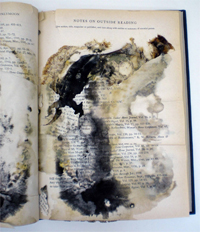Tip 3: Handle With Care
The way you handle your collections can greatly affect their condition and longevity. Here are some tips for proper handling:

Do not eat or drink around collections.
Food and drink, even water, can cause permanent staining and can attract insects, mice and other undesirable critters which in turn may feast on your family bible.
Wash your hands.
Clean your hands and dry them thoroughly prior to using your collections or you may leave stains and food debris behind. This is especially true for photographs and textiles which are very sensitive to the oils and dirt on our hands.
Make sure you have a place to put it.
Before removing a book from the shelf or your mother’s wedding dress from the linen closet, make sure you have a clean, spacious area to lay it down. You can’t clear clutter when your hands are full.
Handle carefully.
Don’t pull books from the shelf by their head caps, don’t drag your mother’s wedding dress along the floor, don’t put fingerprints all over your photographs and don’t use your Grandmother’s fine bone china as frisbees. Avoid paperclips and sticky notes, too. For Pete’s sake, use some common sense and handle your stuff with care and respect.
Tip 4: Display responsibly
We all want to show off our family photographs and children’s art work. There are ways to do it properly, and ways to do it wrong. Here are some good tips for displaying your collections:
Keep away from light.
Light exposure causes fading and embrittlement of paper, photographs and textiles. If you hang things on your walls, keep them away from windows and lights. Before hanging, watch the sunlight patterns on the walls as the day progresses and note where direct sunlight falls. Then hang your pictures in places that don’t receive light.
Environment matters.
See our previous post on controlling the environment. Don’t hang the only photograph of Grandma in the bathroom or keep it in the attic. She will come back to haunt you if you do (at least that is what my Mom says, and she is always right).
Choose a good framer.
Any materials that come in contact with your collections should be made of the best quality materials and should not cause damage. When taking your photos and family papers to be framed, be sure to ask what the pH of the mat board is, what kind of glazing is used (glass or Plexiglas are good choices), and how the item will be attached to the backing (non-adhesive methods are best).
Tip 5: Consider Using Facsimiles
If you have only one of something to use or display, it might be a good idea to have a high quality reproduction made so you can work with that instead of the original. This way you can put the original inside a good enclosure and in a safe location. This is a great idea for things like birth records, family trees from the front of your bible, photographs, children’s drawings and especially for newspaper articles since they are so quick to turn yellow and brittle.
Resources
NEDCC “Matting and Framing for Art and Artifacts on Paper”
Library of Congress “Guide to Preservation Matting and Framing”
National Archives “Should I Digitize My Photo Collection?”


 As part of the Duke University Libraries’ Preservation Week activities, our
As part of the Duke University Libraries’ Preservation Week activities, our 


 Digital objects
Digital objects